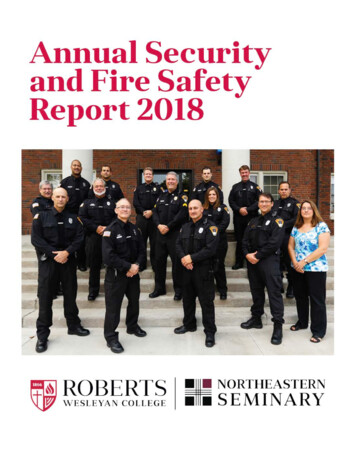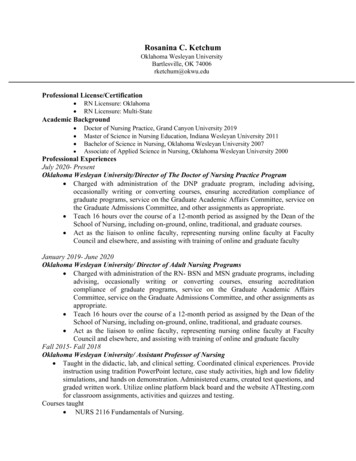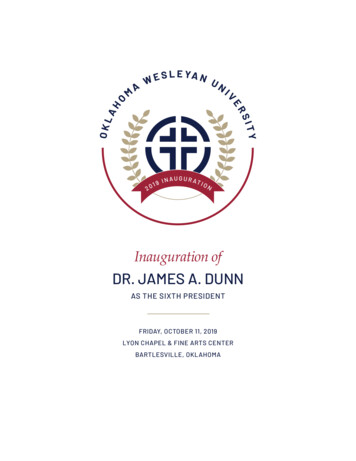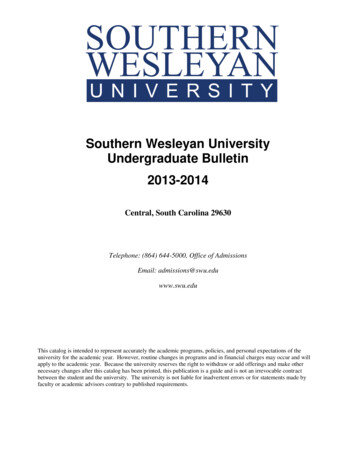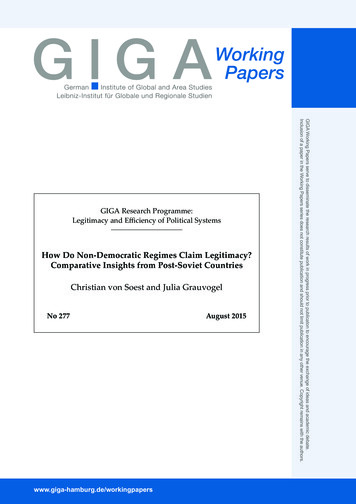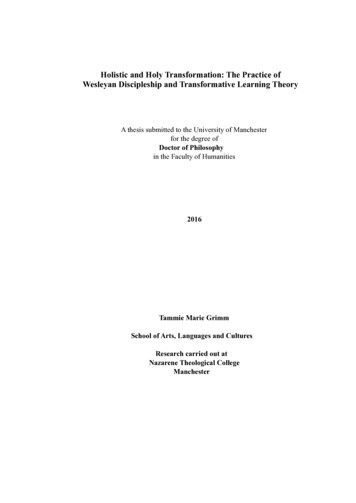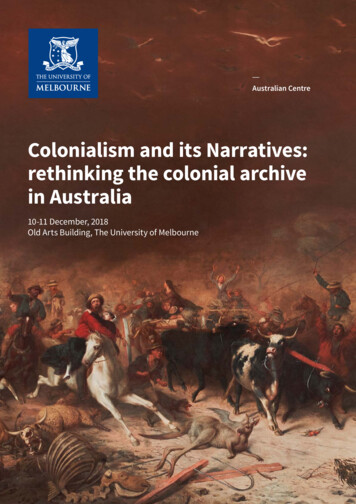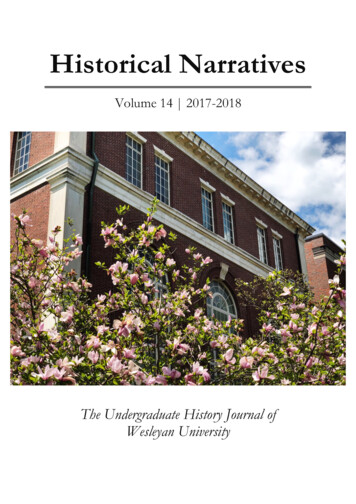
Transcription
Historical NarrativesVolume 14 2017-2018The Undergraduate History Journal ofWesleyan University
Historical NarrativesVolume 14 2017-2018Editors-in-Chief:Steven ChenIlana NewmanHai Lun TanEditorial Staff:Allegra AyidaChristopher CepilAzher JaweedSophie MartinFaculty Advisors:Demetrius EudellGary Shaw
A Note from the EditorsHistorical Narratives is the undergraduate history journal of WesleyanUniversity. In this fourteenth volume of the publication, we continue inthe tradition of celebrating student work while providing a platform foracademic discourse. The pages that follow feature a wide variety of papers,reflecting the multifarious interests of the student body. This collection ofessays consists of environmental, to economic, and social histories whileexploring topics of the Amazon, gender, and religious rhetoric.History, as a profession and discipline, allows us to grapple with and makesense of the past. History also sheds light on and preserves the lives,cultures, and stories of the past. The study of history engages us in a modeof historical thinking that allows us to critique moments of historicalimmorality and constructed narratives. Furthermore, assessing our sharedhistories can inform our present and guide us into the future. Now, morethan ever, historical inquiry urges us to contemplate and evaluate thedimensions of our current socio-economic and political moment.This journal would not have been possible without the enthusiasticcontributions from the student body and the support from the HistoryDepartment. Thank you to the various professors who believe in thepossibilities of undergraduate research. Your knowledge and guidancefostered our transformation from students of history to historians-intraining.Steven Chen, Ilana Newman, and Hai Lun TanEditors-in-Chief
Table of ContentsEl Pueblo de Dios: Mormon Colonization in Mexico and theAppropriation of Indigeneity Through Lamanite IdentificationBrenda Quintana .2The Rubber Tappers in the Amazonian ImaginationHai Lun Tan. . . .31Weapon of the Party: Reform in the Khrushchev EraSamuel McCarthy. .44“The Demon Girl”: Continuity and Change in Religious RhetoricSurrounding Female Criminality from Medieval Europe to NineteenthCentury AmericaLila Levinson 51Debunking the Economic Miracle: An Analysis of West Germany’sEconomyBrian Gerner .68Fishing in the Amazon: Early Accounts of Amazonian Fishing andMore Recent Resource Management Practices in the LowerFloodplains RegionLillian Saul . .78“Noble and Holy”: Religion Within and Without the Knights of LaborLindsay Zelson. . 92The Weird Sisters: The Witchcraft in Macbeth and its HistoricalContextKaitlyn Thomas-Franz . .106Dancing Tables, Queer Time(s): A Not-Straight Case forHistoricizing the NonhumanThomas Reid. 1161
!!El Pueblo de Dios: MormonColonization in Mexico and theAppropriation of Indigeneity ThroughLamanite IdentificationBrenda QuintanaMy family immigrated from Toluca, Mexico to Provo, Utah in theUnited States when I was just one year old. Just a few blocks north of ourapartment was Brigham Young University, a Church of Jesus Christ ofLatter-Day Saints (LDS) temple, and a Missionary Training Center. AMormon cultural stronghold, moving to Provo was hardly coincidental inmy family’s case. As a young man back in Mexico, my father was an activeLDS Church member, having joined at the age of fifteen.1 Many of themotivations for moving to the United States stemmed from his experienceas an LDS missionary serving in Monterrey, Mexico, where he was able tomake contacts within the Mormon community that eventually enabled himto immigrate and find work in the United States.Although my father only remained an active member for a fewyears after coming to the United States, he recalls feeling a sense ofcontradiction and disidentification with the ways the Mormon doctrine wasbeing taught in the United States in comparison to Mexico. A specificmoment of realization for him occurred when he was sharing an apartmentwith two American students in Logan, Utah, and he borrowed their Englishversion of the LDS Institute Manuals. The manuals, which are guides usedfor scripture study, had completely different imagery than what he had !!“Enero de 1980, a los quince años de edad. Mision México Monterrey 1986-1988. Vine a losEstados Unidos después de mi mision en Noviembre de 1988, y continue activo en la iglesia por dosaños después.”12
!!in his Spanish version in Mexico. Whereas his old manual back in Mexicodepicted Mesoamerican and indigenous imagery, such as the Aztec pyramidsand artifacts, his housemates’ carried images of colonial America and theFounding Fathers.2 These images, normally shared in other LDSpublications, served the purpose of situating the “Promised Land” depictedin the Book of Mormon in a precolonial and colonial America.Back in Mexico, my father told me that Mormon church leadersand missionaries, who would often be Anglo Americans, would directly castMexican mestizo and indigenous members as being descendants of theLamanites. In the Book of Mormon, the Lamanites, along with theNephites, are understood as being the first inhabitants of the New Worldand considered descendants of the House of Israel.3 The Americanmembers would teach new converts that they should be orgullosos (proud) ofbeing Lamanite descendants and that they were part of el Pueblo de Dios(God’s people).4 Cultural signifiers of Mexico’s indigenous ancestry weretaken up as evidence of the Lamanites’ lingering influence, which in turnencouraged national pride. For my father, Lamanite identification had moreto do with bringing additional attention to an existing cultural heritage, thanit had to do with taking up a new historical identity. However, when myfather got involved with the Church in the United States, Lamaniteidentification of Mexicans became less prominent and almost nonexistent ina predominantly white, Anglo-centric culture.My father’s experience reflects the ways in which Lamaniteidentification has been exercised in deliberate and strategic ways to advanceMormon proselytizing efforts in Mexico, particularly among prospectivemestizo and indigenous members. Although my father’s experience isrelatively recent, the politics of Lamanite identification are rooted in a !!Although I do not have access to any physical manuals to verify the difference, the English versionmanuals are available online and in Chapter 4 of the Book of Mormon Manual, there are images ofChristopher Columbus and the American flag in a “sequence of events leading to the establishmentof God’s Kingdom.”3 The Lamanites would eventually outlast the Nephites, explaining why it is commonly understoodthat Indigenous Americans are descendants of Lamanites.4 I use “Anglo American” interchangeably to “White American,” with preference given to historicaltimeframe and likelihood of self-identification with these terms.23
!!history of Mormon proselytism and settler colonialism in Mexico, dating toback to the mid- to late nineteenth century. Many early attempts atestablishing colonies and mission sites were met with internal conflict andexternal resistance. Internal conflicts were largely defined by disagreementsabout the role of the Church in Mexico or conflicting interpretations of theBook of Mormon, specifically as it related to the status of convertedmembers. External resistance to the Mormon Church during moments ofpolitical revolution and reformation were primarily concerned with theassociation of the Church with American imperialism and colonialism.Ultimately, a majority of these early colonial projects had to be discontinuedand often resulted in the excommunication of dissenting converts. The twomost notable examples that have set a foundation for Mormon participationin Mexico include the first short-lived Mexican Mission (1879-1889) andcolonization efforts in the Northern Mexican states of Chihuahua andSonora (1885-1912*).5In this essay, I will be using Patrick Wolfe’s conceptualization ofsettler colonialism as a “logic of elimination” to analyze the role of the Bookof Mormon in displacing indigenous histories and justifying Churchexpansion through the imposition of Lamanite identities on indigenous andmestizo Mexicans. Examining how Lamanite identification was used tosupport settler colonial projects, such as the establishment of the MexicanMission and Mormon Colonias, reveals the extent in which indigeneity wasappropriated and manipulated within Mormon ideology. Acknowledging thecapacity of Lamanite identification to be internalized, as well as strategicallyexercised by indigenous or mestizo members, examining the role of a fewnotable Mexican converts in the Church allows for an understanding of howindigenous and Lamanite identities were exercised to negotiate claims topower within the Church. Nonetheless, identifying Mexico mestizos asLamanite works within an existing colonial logic defined by !!!!!The timeline attributed to the established Colonies is defined by the year the land was purchased,and the year of the last Mormon “Exodus” after being removed from their property by Mexicanrebel armies. However, the timeline is a bit more complicated considering that there are a fewColonies that were resettled after the Mexican Revolution and two main colonies that are still run bythe descendants of original Mormon colonists in Mexico today.54
!!nationalism, that perpetuates the elimination of the native by furtherdistancing Lamanite narratives from actual indigeneity.Background: Mormon Colonization on the FrontierThe Church of Jesus Christ of Latter-day Saints, founded in 1830by Joseph Smith in Palmyra, New York, was one of the many religiousgroups that grew out of the Second Great Awakening. During the sameperiod that the Church was founded, the United States had started toexpand further westward, defined primarily by the Louisiana Purchase fromthe start of the century. The year of 1830 was also marked by the signing ofthe Indian Removal Act, which forcefully uprooted and displacedindigenous tribes west of the Mississippi River. The establishment of theMormon Church and the development of their ideological framework wouldbe significantly influenced by American westward expansion and thedisplacement of indigenous nations. Even before the completion of theBook of Mormon, there were a series of “revelations,” or instructions fromGod, expressed by Joseph Smith and other founding members that set intomotion Mormon missionary work in the newly acquired Western territories.6Consequent revelations also designated the Book of Mormon as being“written primarily ‘to the Lamanites,’” and instructed members to “go untothe Lamanites & Preach [the] Gospel unto them.”7The first Mission to the Lamanites, which lasted only a year, sentthree missionaries to western Missouri to proselytize among the displacedIndian communities past the Missouri frontier, which was referred to as the“border of the Lamanites” by Mormons. Aside from proselytizing to !“Revelations” are expressed as being a direct communication to God. Within Mormon ideology,Prophets are the only people who can receive revelation for the Church, however, anyone who issaid to be faithful, is capable of receiving individual revelations from God.: Richard Dilworth Rust,“A Mission to the Lamanites,” The Church of Jesus Christ of Latter-Day Saints: History, February22, 2013, ants-lamanite-mission?lang eng; TheChurch of Jesus Christ of Latter Day Saints, “Revelation,” The Church of Jesus Christ of Latter-DaySaints, accessed December 16, 2017, www.lds.org/topics/revelation.7 "Revelation, September 1830–B [D&C 28]," The Joseph Smith Papers, accessed December 16,2017, 41, elation-september-1830-b-dc28/2.65
!!presumed descendants of the Lamanites, this mission was instrumental inthe establishment of Mormon settlements in Ohio and Missouri.8Consequent “revelations” calling for the “gathering of saints” in eachrespective settlement set in motion the westward migration of Mormonmembers from the original site of New York.9 However, Mormonsettlements were often met with resistance by surrounding Protestantcommunities and prominent leaders were regularly persecuted by variouslocal and state officials.10 Their religious practices and social organizationswere considered transgressive, anti-American, and a threat to westerncivilization by other American citizens. As scholar Jason Dormady wouldnote, “early converts to Mormonism were used to existing on the fringes ofAmerican society,” and the isolation that settlement in the West promisedwas especially appealing to key leaders in the Church, who continued to bepersecuted.16Initial plans for western colonization were torn between settling inthe “Great Basin” (also known as the Great Salt Lake area) or NorthernMexico.11 The primary goal was to be just beyond federal reach. Thedecision to settle in the Great Basin was ultimately made by Brigham Young,who took the place of Joseph Smith as the new church President followingSmith’s assassination. Young, referred to as the “Great Colonizer” withinofficial Church statements, led the first group of Mormon pioneers into SaltLake City Valley in 1847. Nonetheless, plans to settle in Mexico wererevisited in the subsequent decades as the Salt Lake area came under U.S.federal control and anti-bigamy act threatened to seize Church property inthe Utah territory.To encourage members to migrate to the West, Church leadershipestablished the “unsettled” West as a divine site for the gathering of !!!!Daniel H. Ludlow, “Lamanite Mission of 1830-1831,” Encyclopedia of Mormonism (New York:BYU Harold B. Lee Library, 1992), ction/EoM/id/4391.9 Doctrine and Covenants 37: 3.10 The Lamanite Mission was cut short after an order to desist was issued by federal Indian agent,Richard W. Cummins, with repeated threats of arrest if missionaries did not leave Indian lands.11 Jason H. Dormady, “Introduction: The Mormons in Mexico,” in Just South of Zion: The Mormons inMexico and Its Borderlands (University of New Mexico Press, 2015), 2.86
!!by ascribing qualities associated with the characters and events of the Bookof Mormon onto the land. Joseph Smith enforced this idea by identifyingindigenous peoples and their cultural artifacts as belonging to theLamanite.12 More broadly, it was the attribution of “wilderness” and“uncivilized” to indigeneity that helped enforce the representation of theunsettled West as being more purely rooted in its Lamanite history. BecauseMormon Gentiles (what Anglo-American Mormons identified as) are said toinherit the Promised Land alongside the redeemed Lamanites in the Book ofMormon, settling on or near indigenous land also reflected an ideologicalfantasy of cohabitation.13Many of these initial colonization projects that defined earlyChurch growth and expansion in the United States were intimatelyconnected to the moving borders and frontiers, often seeking to be just outof reach of American legal persecution or control. Furthermore, situatinglater attempts to organize missionary work and colonias in Mexico inrelation to the establishment of the Church on the American Frontierreinforces why the imagined historical character of the Lamanite is soimportant. Mormon colonization and proselytism are centered on apaternalistic, ideological relationship with indigeneity and indigenous land.Lamanite Characterization and IdentificationAs addressed earlier, the Book of Mormon is said to have beenwritten “to the Lamanites,” and is presented as a collection of writingswritten by the ancient peoples identified as the “original colonist in the NewWorld.”14 The first two sections in the Book of Mormon are written by !John-Charles Duffy, “The Use of ‘Lamanite’ in Official LDS Discourse,” Journal of Mormon History34, no. 1 (2008): 125.13 2 Nephi 30:1 “Converted Gentiles will be numbered with the covenant people—Many Lamanitesand Jews will believe the word and become delightsome—Israel will be restored and the wickeddestroyed.”14 Alysa Landry, “How Mormons Assimilated Native Children,” Indian Country Today MediaNetwork, January 11, 2016, 11/howmormons-assimilated-native-children-162962; Lane Johnson, “Who and Where Are the Lamanites?”The Church of Jesus Christ of Latter-Day Saints, December, ere-are-the-lamanites.127
!!imagined historical character Nephi, who documents the escape of Israelitefamilies from Jerusalem during 600 BCE. Over time these familieseventually split off into two groups, each following either the patriarchLaman (of the namesake Lamanites) or Nephi (whose followers are referredto as the Nephites). Over the centuries these two groups started to acquiredistinguishing qualities which reflected their moral characters. The Nephites,who primarily followed the teachings of Christ, were represented as being“white, and exceedingly fair and delightsome,” whereas the Lamanites, a“loathsome” and “idle” people, were marked by a “skin of blackness.”15Despite the condition of the Lamanites, the Book of Mormon says thatthrough conversion, the Lamanites could be redeemed so that their “scalesof darkness shall begin to fall from their eyes. and they shall be a pure* anda delightsome people.”16 Centuries of war between the two groups led to thedemise of the Nephites as a collective. As a result, contemporary indigenouspeople are often read as descendants of the Lamanites, whose “dark”characteristics have also been used to signal racial difference. In theliterature referencing the role of race in the Mormon Church, the depictionof the Lamanite has been the most controversial. It is largely understood asbeing a product of its time, where “whiteness” was used interchangeablywith moral purity, but also reflected a racist understanding of the origin ofpeople of color.17]The language of “redemption” is heavily exercised in Churchdoctrine regarding Gentile relationships with Lamanites, often functioningunder a paternalistic dynamic. Proselytizing, as practiced by Mormons,grants the gentile Anglo-American members the authority to !!!2 Nephi 5:21 “Wherefore, as they were white, and exceedingly fair and delightsome, that theymight not be enticing unto my people the Lord God did cause a skin of blackness to come uponthem”16 2 Nephi 30:6 “their scales of darkness shall begin to fall from their eyes; and many generationsshall not pass away among them, save they shall be a pure* and a delightsome people.” The word“white” was replaced with “pure” during a revision of the Book of Mormon in 1981.17 Armand L. Mauss, All Abraham’s Children: Changing Mormon Conceptions of Race and Lineage(Urbana: University of Illinois Press, 2003); See also Edward J. Blum and Paul Harvey, The Color ofChrist: The Son of God & the Saga of Race in America (Chapel Hill: University of North CarolinaPress, 2012).158
!!indigenous communities a version of their own history, in an effort toredeem them of their spiritual conditions. The Book of Mormon both“glorifies and condemns” the Lamanites by portraying them as a racialized“fallen people,” as well as the “promised people,” who are “destined” toinherit the land upon acceptance of the “true gospel.”18 The disbelief inChrist turns the Lamanites into a “dark, and loathsome, and a filthy people,full of idleness and all manner of abominations” and belonging to thewilderness.19 However, conversion promises to redeem the Lamanite andeliminate traces of the curse, making them “white and delightsome.”20Through redemption, the descendants of the Lamanites can then makeclaim to their ancestral promised land. Claims to land and belonging are thencontingent on approval of the gentile Anglo-American Mormon leadershipfor conversion. Along with conversion, there is an expectation that theyreject parts of their existing indigenous culture and identity, and distancethemselves from the “wildness” to become civilized. Although Mormonmillennialism is unique in that it does envision the reclaiming of Indigenouslands, in practice these claims remain spiritually symbolic.21In “The Use of ‘Lamanite’ in Official LDS Discourse,” JohnCharles Duffy chronicles the use of the term “Lamanite” throughout theChurch’s history, bringing attention to the stakes involved in Church leadersexercising certain definitions of Lamanite. The initial function of the NorthAmerican Lamanite allowed for an understanding of an unfamiliar peopleand landscape to be grounded in an existing ideology.22 Although Lamaniteidentification was primarily limited to North American Indians during thefirst few decades of the establishment of the Church, the label eventuallygrew to include other indigenous people as the Church began to open upmissions in other countries. Parley P. Pratt, who served as an Apostle in theLDS Church and spearheaded the first Mission to Chile, wrote aproclamation directed to “the people of the coasts and islands of the !!!!!!Landry, “How Mormons Assimilated Native Children.”1 Nephi 12:23, 2 Nephi 5:2420 2 Nephi 30:6; Landry, “How Mormons Assimilated Native Children.”21 Duffy, “The Use of ‘Lamanite’ in Official LDS Discourse,” 131.22 Duffy, “The Use of ‘Lamanite’ in Official LDS Discourse,” 125.18199
!!of every nation, kindred and tongue” in 1851. One of the proclamationschapters, “Address to the Red Man,” explicitly included Peruvians,Mexicans, and Guatemalans alongside North American Indians as belongingto the “branch of the house of Israel.”23 As different native groups cameunder the Lamanite label as the Church continued to expand abroad, thescriptural logic relied heavily on developing understandings of Ancientcultures during the 19th century. However, research and explorations ofindigenous land, people, and artifacts often perpetuated racistrepresentations of indigeneity.The ability for the label to expand allowed for open interpretationand identification, which was particularly useful when justifying colonizationand missionary projects outside of the United States. Distance also becamean important factor in Lamanite identification for indigenous people fromLatin America and the Pacific Islands. Following the Mormon Pioneerwestward movement during the mid-nineteenth century, Mormons cameinto direct contact with North American Indians, which sparked conflicts asthey often competed for resources and space. Duffy notes that like manyother white settlers, Mormons came to “regard the Indians with ‘disgust andloathing.’”24 By redirecting emphasis on indigenous people abroad, theywere able to exercise a degree of distance that made room for moresympathetic representations. When the Mexico mission was dedicated byApostle Moses Thatcher in 1881, he declared it a chance to “redeem theLamanites in that Land,”25 The pointed “that Land” signaled a land ofOthers that existed away and apart from Mormon settlements in the UnitedStates.Coming into the twentieth-century, there was also a significant shiftin Lamanite identification that began to take on an overt racial identity !Parley P. Pratt, “Proclamation! To the People of the Coasts and Islands of the Pacific, of EveryNation, Kindred and Tongue,” C.W. Wandell, 1851. L. Tom Perry Special Collections, Harold B.Lee Library, Brigham Young llection/NCMP1820-1846/id/17392.24 Duffy, “The Use of ‘Lamanite’ in Official LDS Discourse,” 129; Juanita Brooks, "Indian Relationson the Mormon Frontier," Utah Historical Quarterly 12 (January-April 1944); 12.25 F. LaMond Tullis, Mormons in Mexico: The Dynamics of Faith and Culture (Logan: Utah StateUniversity Press, 1987), 41.2310
!!to the emphasis on bloodlines and lineages. Mormon doctrines continued tosuggest that Native Americans and Pacific Islanders belonged to a “singleracial stock” defined by Israelite blood.26 There was a belief that theLamanites of Mexico and the rest of Latin America were less likely to havetheir Israelite blood diluted or “contamination” through miscegenation withother bloodlines, unlike the Lamanites of the United States.27 Lamaniteidentification relied on a racial logic for the preservation of these ancientlineages that made scriptural destiny predetermined and inheritable.Concerns over “amixture” also manifested themselves in prejudiced feelingstowards Mexican mestizos. During Mormon colonization efforts in theAmerican Southwest in the 1880s, colonizer Jesse Smith believed that “‘theblood of Cain was more predominant in those Mexicans than that of Israel’because they ‘carried not just the blood of Spanish and Indians, but also theblood of Africans.’”28 Although it was precisely this racial “mixture” whichqualified Mexicans as Lamanites, it was also used to challenge their claims tothe lineage. Although there are various conflicting views held by Mormonmembers, the doctrine itself does little to address the instability that mixedcolonial identities might pose to these imagined indigenous lineages. Thisinstability in the label results in a series of conflicts in colonization andproselytizing efforts.The racialization of lineage is primarily a product of social andintellectual movements led by Mormon leaders with the interpretation of keyfigures carrying particular weight in the century following the westernsettlement of Mormons. Lamanite identification is racialized over time as theMormon Church continued to grow throughout Latin America and thePacific Islands to maintain and center Gentile Anglo-American leadership.Ultimately, designating a people as Lamanites preserves the colonialauthority of non-indigenous settler Mormon members by granting themprimary authority over religious !!!!!!!!!Duffy, “The Use of ‘Lamanite’ in Official LDS Discourse,” 133-134.Anthony W. Ivins, Conference Report, April 1901, 58.28 Daniel Herman, “Calls to War, Calls to Peace: Mormons among New Mexicans in 1880sArizona,” in Just South of Zion: The Mormons in Mexico and Its Borderlands (University of New MexicoPress, 2015), 135-136.262711
!!Mexican Mission: The Failure of the First EncounterAs early as 1874, Brigham Young had announced intentions forsetting up a mission in Mexico in order to “take the gospel to Lehi’s millionsof Mexican descendants.”29 In order to lay the groundwork for missionarywork in Mexico, Brigham Young recruited Daniel Webster Jones andMeliton Gonzalez Trejo to translate sections of the Book of Mormon intoSpanish. The published series of texts, called Trozos Selectos del Libro deMormon (Selected Portions from the Book of Mormon, were printed and distributedin 1875 to various individuals in Mexico to gauge interest before theestablishment of a mission site. Jones, who had also been called to head themission in 1874, led a group of missionaries to scout out possiblecolonization sites “along the Little Colorado River in Arizona and in theMexican states of Chihuahua and Sonora.”30These initial engagements with Mexico, particularly as they relatedto the key figures like Jones and Trejo, are largely predicated on memberparticipation in the Mexican-American War. Many Mormon membersparticipated in the war, either individually or on behalf of the speciallyorganized “Mormon Battalion”, a group of Mormon soldiers that werestrategically used to occupy and invade parts of New Mexico and Californiain order to place pressure on the Mexico to ceded the contested land andrewrite the Southwestern border.31 Daniel Webster Jones, an instrumentalfigure in Mormon colonization in Mexico, learned Spanish during his timeas a volunteer soldier in the Mexican-American War and developed ehi is the patriarch of Nephi and Laman who lead the voyage to the New World in the Book ofMormon. References to the “children of Lehi” should be read as being grounded in a similar logic asLamanite identification; Tullis, Mormons in Mexico: The Dynamics of Faith and Culture, 14; DanielWebster Jones, Forty Years Among the Indians: A True Yet Thrilling Narrative of the Author’sExperiences Among the Natives, Juvenile instructor office, (1890): 220.30 Jared Tamez, “‘Out of This Part of Babylon’: Colonizing Mexican Mormons and the Decline ofthe Mexican Mission of the Church of Jesus Christ of Latter-Day Saints, 1879–1889,” M.A., TheUniversity of Utah, 2014, 13.31 Susan Easton Black, “Mormon Battalion,” Utah History Encyclopedia, accessed January 18, 2018,http://historytogo.utah.gov/utah chapters/trappers, traders, and explorers/mormonbattalion.html.2912
!!familiarity of the northern Mexican region through the U.S. militarycolonizing efforts.32Meliton Gonzalez Trejo, the other key figure in the translation ofthe Book of Mormon, was a Spanish convert. Before Trejo came to SaltLake City in 1874 to express his “most fervent desire to translate the Bookof Mormon into Spanish and to take the gospel to his people,” he wasserving as a military officer stationed in the Philippines.33 Although Trejonever got to take the gospel to “his people” in Spain, his work in translatingthe Book of Mormon was instrumental for Mormon proselytizing inMexico. The symbolic implications of Tr
version of the LDS Institute Manuals. The manuals, which are guides used . manuals are available online and in Chapter 4 of the Book of Mormon Manual, there are images of . Book of Mormon, there were a series of "revelations," or instructions from God, expressed by Joseph Smith and other founding members that set into .

